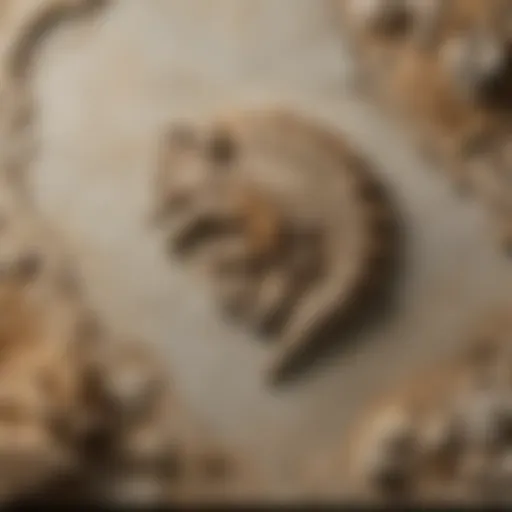Unveiling the Enigmatic Varieties of Gold: An In-Depth Guide for Rock and Fossil Enthusiasts


Rock and Fossil Identification
When delving into the realm of rock and fossil collecting, it is essential to have a keen eye for identifying various types of gold. Native gold, tellurides, and nuggets each possess unique characteristics that distinguish them from one another. Native gold, for instance, is often found as distinctively shiny, metallic nuggets, while tellurides exhibit a more silvery appearance. Nuggets, on the other hand, can range in size and shape, adding a sense of excitement and unpredictability to the collector's quest. By paying attention to texture, color, and structure, collectors can begin to distinguish between these captivating forms of gold. Utilizing tools such as magnifying glasses, streak plates, and hardness picks can further aid in the identification process, allowing collectors to appreciate the intricacies of each specimen they encounter.
Native Gold
Native gold, a pivotal topic in the realm of gold exploration and collection, holds immense significance within the context of this comprehensive guide for rock and fossil collectors. For enthusiasts seeking to delve into the captivating world of geological treasures, understanding the various aspects of native gold becomes essential. This section aims to shed light on the distinct characteristics, historical relevance, and practical considerations associated with native gold specimens, offering a deep dive into its allure.
Characteristics of Native Gold
Color and Luster
When discussing native gold, the aspects of color and luster play a crucial role in distinguishing this precious metal. The rich golden hue coupled with a brilliant luster defines native gold's visual appeal, making it a sought-after choice for collectors and connoisseurs alike. The unique sheen and warm tone of native gold set it apart from other minerals, creating a captivating allure that captures the eye of any observer.
Crystal Structure
The crystal structure of native gold contributes significantly to its overall charm and desirability among collectors. Displaying intricate patterns and formations, the crystal structure adds a layer of complexity and beauty to native gold specimens. The geometric arrangements and interlocking shapes within the crystal lattice further elevate the aesthetic appeal of native gold, showcasing the natural artistry embedded within this precious mineral.
Occurrence in Nature
The occurrence of native gold in nature provides insights into its geological origins and distribution. Typically found in veins or placer deposits, native gold signifies the presence of ancient geological processes that have shaped the Earth's crust over millennia. Understanding the natural occurrence of native gold enhances the appreciation for its rarity and beauty, offering enthusiasts a glimpse into the intricate web of natural forces at play.
Historical Significance
Ancient Civilizations
In the annals of history, native gold held a revered status among ancient civilizations, symbolizing wealth, power, and divine connection. From the opulent treasures of Egyptian pharaohs to the intricate adornments of Mesopotamian royalty, native gold served as a symbol of prosperity and prestige across cultures. Its historical significance underscores the enduring fascination with this precious metal throughout human civilization.
Gold Rush Era
The Gold Rush era of the 19th century marked a pivotal moment in the global discovery and exploitation of native gold deposits. Triggering mass migrations, economic booms, and cultural shifts, the Gold Rushes of California, Australia, and South Africa reshaped landscapes and livelihoods. The legacy of the Gold Rush era continues to resonate in the collective memory, representing both the allure of wealth and the harsh realities of frontier life.
Symbolism
Beyond its material value, native gold carries profound symbolism in various cultural and artistic contexts. Symbolizing purity, prosperity, and endurance, gold's symbolic meanings transcend mere monetary worth to embody deeper spiritual and symbolic significance. Whether adorning religious artifacts or crowning esteemed achievements, the symbolism of gold weaves a thread of cultural continuity throughout human history.
Collecting Native Gold Specimens
Where to Find
Identifying the prime locations for discovering native gold specimens forms a crucial aspect of a collector's journey. From historic mining regions to geological hotspots, knowing where to find native gold enhances the thrill of exploration and discovery. Seeking out reputable sources and exploring diverse terrains can unveil hidden treasures waiting to be unearthed.
Preservation Tips


Preserving the integrity and beauty of native gold specimens requires careful attention to storage and handling practices. Shielding specimens from humidity, contaminants, and physical damage is essential for maintaining their luster and appeal over time. Employing conservation-grade materials and techniques ensures that native gold specimens retain their splendor for future generations to admire.
Displaying Techniques
Effectively showcasing native gold specimens adds a layer of artistry to their scientific and aesthetic value. Employing elegant mounting solutions, lighting techniques, and display arrangements can elevate the impact of native gold collections. Creating immersive displays that highlight the natural beauty and unique characteristics of each specimen invites viewers to appreciate the allure and complexity of native gold in a curated setting.
Gold Alloys
Gold alloys play a pivotal role in the realm of rock and fossil collecting, adding a layer of sophistication and uniqueness to the collectibles. The blending of gold with other metals results in a diverse range of alloys, each with its distinct properties and visual appeal. These alloys not only enhance the aesthetic value of rock and fossil specimens but also contribute to their historical and cultural significance, making them sought-after pieces for collectors with a keen eye for rarity and quality.
Types of Gold Alloys
Electrum
Electrum, a natural gold-silver alloy, stands out for its unique composition and inherent beauty. Its delicate balance of gold and silver imparts a soft, lustrous sheen that sets it apart from other alloys. Collectors are drawn to Electrum for its historical relevance, as it was widely used in ancient jewelry and coinage. This alloy's malleability and resistance to tarnishing make it a favored choice among artisans and collectors looking to preserve the authenticity of traditional gold artifacts.
White Gold
White Gold, a blend of gold with white metals like nickel or palladium, offers a modern and sophisticated alternative to traditional yellow gold. Its distinct pale hue and versatility in jewelry design make it a popular choice for contemporary collections. While White Gold's strength and durability make it ideal for intricate craftsmanship, its rhodium plating may require periodic maintenance to maintain its pristine appearance.
Rose Gold
Rose Gold, featuring a blend of gold with copper, exudes a warm and romantic aesthetic that has garnered popularity in recent years. Its soft pink hue adds a touch of elegance to jewelry pieces, capturing the essence of timeless beauty. Rose Gold's durability and compatibility with various gemstones make it a favored choice for creating exquisite jewelry designs that resonate with modern trends, appealing to collectors seeking a blend of classic and contemporary styles.
Applications in Jewelry
Craftsmanship
The intricate craftsmanship involved in working with gold alloys elevates the artistic value of jewelry pieces, showcasing the skill and dedication of master craftsmen. The meticulous attention to detail, from intricate metalwork to stone setting, ensures that each piece is a masterpiece of precision and beauty. Collectors appreciate the artistry displayed in creating unique and timeless jewelry that reflects the rich heritage of goldsmithing traditions.
Durability
Durability is a key factor in the appeal of gold alloys for jewelry making, ensuring that pieces withstand daily wear and maintain their allure over time. Gold alloys with enhanced strength and resilience offer collectors peace of mind, knowing that their treasures will remain intact and radiant for generations to come. The intrinsic robustness of these alloys provides a solid foundation for showcasing intricate designs and precious gemstones, enhancing their longevity and value.
Design Trends
Design trends play a significant role in shaping the aesthetic appeal of gold alloy jewelry, reflecting evolving tastes and style preferences. Innovations in design techniques and materials influence the creation of avant-garde pieces that captivate collectors with their ingenuity and originality. Staying attuned to current design trends allows collectors to curate a diverse and contemporary collection that resonates with their individual style and artistic sensibilities.
Chemical Composition
Au-Ag Alloys
The composition of Au-Ag alloys, combining gold with silver, results in a versatile and visually striking material that presents a myriad of design possibilities. The subtle interplay between gold and silver imparts a unique luster to jewelry pieces, enhancing their aesthetic appeal and refined elegance. Collectors are drawn to Au-Ag alloys for their understated charm and seamless integration with various gemstones, making them a favored choice for creating classic and timeless jewelry with a modern twist.
Au-Cu Alloys


Au-Cu alloys, blending gold with copper, showcase a vibrant and warm color palette that radiates a distinct charm and character. The rich tones of copper infused with the brilliance of gold create a captivating contrast that adds depth and visual interest to jewelry designs. Collectors appreciate the earthy appeal and rustic elegance of Au-Cu alloys, making them a popular choice for creating bold and expressive pieces that exude individuality and style.
Au-Pt Alloys
Combining gold with platinum in Au-Pt alloys results in a luxurious and sophisticated material that epitomizes opulence and refinement. The inherent strength and purity of platinum complement the timeless beauty of gold, creating a harmonious fusion of metals that elevates the allure of jewelry pieces. Collectors value Au-Pt alloys for their rarity and exclusivity, appreciating the unique blend of elegance and durability that defines these precious creations.
Gold Tellurides
Gold tellurides play a crucial role in the intricate tapestry of gold exploration, adding a layer of complexity and intrigue to the ever-evolving landscape of rock and fossil collecting. Their presence not only highlights the diverse forms of gold but also showcases the scientific and historical significance associated with these unique minerals. Exploring gold tellurides provides enthusiasts with a deeper understanding of the geological processes that have shaped our planet and influenced the distribution of precious metals.
Formation and Properties
Tellurium Content
Delving into the tellurium content of gold tellurides unveils a distinct aspect that sets them apart from other gold formations. Tellurium, a metalloid element, binds with gold to create telluride minerals, contributing to their distinctive properties and characteristics. The inclusion of tellurium enhances the physical and chemical attributes of these minerals, offering collectors a glimpse into the diverse composition of gold in nature.
Structural Characteristics
The structural characteristics of gold tellurides encompass a range of unique features that distinguish them within the mineralogy domain. Their crystalline structure, influenced by tellurium content, exhibits intricate patterns and formations that intrigue researchers and collectors alike. Understanding the structural nuances of gold tellurides sheds light on their formation and presence in different geological settings, unlocking a wealth of information for enthusiasts.
Geological Settings
Exploring the geological settings where gold tellurides thrive uncovers a wealth of insights into their distribution and prevalence in specific regions. From hydrothermal deposits to magmatic environments, these minerals exhibit a preference for distinct geological settings that offer clues about their formation and alteration over time. Evaluating the geological context of gold tellurides enhances our understanding of the Earth's processes and the intricate interplay of minerals within the rock cycle.
Significance in Mineralogy
Unique Crystal Forms
The unique crystal forms displayed by gold tellurides present a captivating study in mineralogy, showcasing nature's artistic work at a microscopic level. These crystals, shaped by environmental conditions and mineral interactions, offer a glimpse into the intricate processes that govern crystalline growth in nature. Collectors and researchers keen on mineral aesthetics find gold telluride crystal forms both inspiring and informative, enriching their exploration of geological treasures.
Association with Gold Ores
The association of gold tellurides with traditional gold ores provides an intriguing link to the broader spectrum of gold mineralization. Understanding how these telluride minerals coexist and interplay with native gold unveils a complex web of geological processes that have influenced their formation and distribution. By examining their relationship with gold ores, collectors gain valuable insights into the interconnected nature of mineral formations and the factors shaping their geological expression.
Identification Challenges
Navigating the identification challenges associated with gold tellurides offers collectors a unique opportunity to test their mineralogical knowledge and observational skills. The subtle differences in physical properties and crystal forms between various telluride minerals pose a stimulating challenge for enthusiasts seeking to distinguish one specimen from another. Overcoming identification hurdles not only enhances collectors' expertise but also fosters a deeper appreciation for the nuanced world of gold tellurides.
Rare Telluride Minerals
Sylvanite
Sylvanite stands out as a notable representative of rare telluride minerals, showcasing a blend of gold and silver within its crystalline structure. This unique composition grants sylvanite distinct properties that make it a sought-after specimen among mineral collectors and researchers. Exploring the characteristics and formation of sylvanite offers a glimpse into the diverse world of telluride minerals and their significance in geological studies.
Calaverite


Calaverite, recognized for its striking golden-yellow appearance, embodies the allure of rare telluride minerals in the realm of geological treasures. Its distinct coloration and crystal habits distinguish it from other gold tellurides, adding a touch of elegance to mineral collections worldwide. Unraveling the properties and geological significance of calaverite enriches our understanding of telluride mineralogy and the intricate processes that govern mineral formation.
Nagyagite
Nagyagite emerges as a fascinating telluride mineral known for its complex chemical composition and unique crystal structure. Comprising a blend of silver, lead, and antimony alongside gold and tellurium, nagyagite presents a puzzle for mineralogists and collectors alike. Exploring the intricate features and associations of nagyagite offers a glimpse into the dynamic world of rare telluride minerals, enriching the exploration of geological specimens with its intriguing attributes.
Gold Nuggets
Gold nuggets hold a significant position in the realm of rock and fossil collecting due to their unique characteristics and historical allure. These natural formations embody the essence of discovery and adventure that attracts collectors and enthusiasts alike. In this section, we will delve deep into the origins and distinct features of gold nuggets, shedding light on their value and importance in the world of geological treasures.
Origins and Characteristics
Placer Deposits
Placer deposits play a crucial role in the formation of gold nuggets, being the primary source of these prized specimens. The process of erosion and sedimentation leads to the concentration of gold particles in riverbeds and streams, creating ideal conditions for the accumulation of nuggets. This natural phenomenon underscores the significance of placer deposits in supplying collectors with exceptional specimens for exploration and study.
Shape and Size Variations
The diversity in shape and size of gold nuggets adds to their allure and desirability among rock and fossil collectors. From intricate crystalline structures to smooth, rounded forms, each nugget tells a unique story of its journey through geological processes. Understanding the distinct shapes and sizes of these nuggets provides valuable insights into their formation and geographical origins, enriching the collector's experience and knowledge.
Distinguishing Features
Gold nuggets possess distinguishing features that set them apart from other gold forms, such as veins or grains. These features include the nugget's surface texture, color variations, and presence of accompanying minerals. Recognizing these distinctive characteristics is essential for identifying authentic gold nuggets and discerning their value in the world of geological collections. By exploring these distinguishing features, collectors can truly appreciate the intricate nature of each nugget.
Prospecting and Collection
Gold Rush Legacies
The legacy of past gold rushes continues to influence modern-day prospecting and collection practices. The romanticized tales of gold discovery and mining operations serve as inspirations for aspiring collectors embarking on their own treasure hunts. Understanding the historical significance of gold rushes offers a glimpse into the adventurous spirit that drives enthusiasts to search for hidden treasures and uncover the mysteries of the earth's treasures.
Modern Techniques
Advancements in technology have revolutionized the way gold nuggets are prospected and collected, enabling enthusiasts to employ sophisticated tools and methods in their search for these elusive specimens. From metal detectors to specialized excavation equipment, modern techniques enhance the efficiency and precision of gold prospecting, providing collectors with new avenues for discovery and exploration.
Legal Considerations
Navigating the legal landscape surrounding gold nugget collection is essential for ensuring compliance with regulations and ethical practices. Various jurisdictions have specific laws governing the extraction and ownership of gold nuggets, emphasizing the importance of conducting responsible and lawful prospecting activities. By adhering to legal considerations, collectors can preserve the integrity of their collections and contribute to the sustainability of geological conservation efforts.
Value and Preservation
Economic Significance
The economic significance of gold nuggets extends beyond their intrinsic value as geological specimens, offering insights into broader market trends and historical contexts. As prized collectibles and investment assets, gold nuggets play a role in shaping the dynamics of the precious metal market and reflecting shifts in consumer demand and sentiment. Exploring the economic significance of these nuggets provides a nuanced understanding of their enduring appeal and cultural significance.
Care and Storage Tips
Proper care and storage are essential aspects of preserving the beauty and integrity of gold nugget collections. Factors such as exposure to humidity, temperature fluctuations, and environmental contaminants can impact the quality and appearance of nuggets over time. By following expert-recommended tips on cleaning, handling, and displaying gold nuggets, collectors can ensure their prized specimens retain their luster and value for generations to come.
Authentication Methods
Authenticating gold nuggets is a critical process in verifying their purity, origin, and craftsmanship. Various methods, including visual inspection, chemical analysis, and laboratory testing, are employed to confirm the authenticity of nuggets and distinguish them from counterfeits or artificially enhanced specimens. By understanding the intricacies of authentication methods, collectors can confidently identify genuine gold nuggets and build reputable collections based on trust and expertise.







